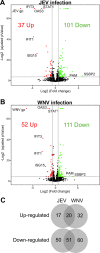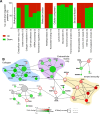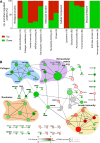Comparison of a human neuronal model proteome upon Japanese encephalitis or West Nile Virus infection and potential role of mosquito saliva in neuropathogenesis
- PMID: 32374750
- PMCID: PMC7202638
- DOI: 10.1371/journal.pone.0232585
Comparison of a human neuronal model proteome upon Japanese encephalitis or West Nile Virus infection and potential role of mosquito saliva in neuropathogenesis
Abstract
Neurotropic flavivirus Japanese encephalitis virus (JEV) and West Nile virus (WNV) are amongst the leading causes of encephalitis. Using label-free quantitative proteomics, we identified proteins differentially expressed upon JEV (gp-3, RP9) or WNV (IS98) infection of human neuroblastoma cells. Data are available via ProteomeXchange with identifier PXD016805. Both viruses were associated with the up-regulation of immune response (IFIT1/3/5, ISG15, OAS, STAT1, IRF9) and the down-regulation of SSBP2 and PAM, involved in gene expression and in neuropeptide amidation respectively. Proteins associated to membranes, involved in extracellular matrix organization and collagen metabolism represented major clusters down-regulated by JEV and WNV. Moreover, transcription regulation and mRNA processing clusters were also heavily regulated by both viruses. The proteome of neuroblastoma cells infected by JEV or WNV was significantly modulated in the presence of mosquito saliva, but distinct patterns were associated to each virus. Mosquito saliva favored modulation of proteins associated with gene regulation in JEV infected neuroblastoma cells while modulation of proteins associated with protein maturation, signal transduction and ion transporters was found in WNV infected neuroblastoma cells.
Conflict of interest statement
The authors have declared that no competing interests exist.
Figures






Similar articles
-
Bagaza virus inhibits Japanese encephalitis & West Nile virus replication in Culex tritaeniorhynchus & Cx. quinquefasciatus mosquitoes.Indian J Med Res. 2015 Dec;142 Suppl(Suppl 1):S44-51. doi: 10.4103/0971-5916.176618. Indian J Med Res. 2015. PMID: 26905241 Free PMC article.
-
Simultaneous detection of West Nile and Japanese encephalitis virus RNA by duplex TaqMan RT-PCR.J Virol Methods. 2013 Nov;193(2):554-7. doi: 10.1016/j.jviromet.2013.07.025. Epub 2013 Jul 25. J Virol Methods. 2013. PMID: 23892127
-
Development of a triplex RT-qPCR assay for simultaneous quantification of Japanese encephalitis, Murray Valley encephalitis, and West Nile viruses for environmental surveillance.Microbiol Spectr. 2024 Oct 3;12(10):e0136424. doi: 10.1128/spectrum.01364-24. Epub 2024 Aug 20. Microbiol Spectr. 2024. PMID: 39162492 Free PMC article.
-
Astrocytes in Flavivirus Infections.Int J Mol Sci. 2019 Feb 6;20(3):691. doi: 10.3390/ijms20030691. Int J Mol Sci. 2019. PMID: 30736273 Free PMC article. Review.
-
Flavivirus encephalitis: pathological aspects of mouse and other animal models.Vet Pathol. 2010 Sep;47(5):806-18. doi: 10.1177/0300985810372507. Epub 2010 Jun 15. Vet Pathol. 2010. PMID: 20551474 Review.
Cited by
-
GWAS in Mice Maps Susceptibility to HIV-Associated Nephropathy to the Ssbp2 Locus.J Am Soc Nephrol. 2022 Jan;33(1):108-120. doi: 10.1681/ASN.2021040543. Epub 2021 Dec 10. J Am Soc Nephrol. 2022. PMID: 34893534 Free PMC article.
-
Zika virus infection of the placenta alters extracellular matrix proteome.J Mol Histol. 2022 Apr;53(2):199-214. doi: 10.1007/s10735-021-09994-w. Epub 2021 Jul 15. J Mol Histol. 2022. PMID: 34264436 Free PMC article.
-
Potential for Protein Kinase Pharmacological Regulation in Flaviviridae Infections.Int J Mol Sci. 2020 Dec 15;21(24):9524. doi: 10.3390/ijms21249524. Int J Mol Sci. 2020. PMID: 33333737 Free PMC article. Review.
-
Proteome modulation triggers potent antiviral response in Japanese Encephalitis Virus infected human macrophages.Arch Microbiol. 2024 Nov 9;206(12):464. doi: 10.1007/s00203-024-04167-1. Arch Microbiol. 2024. PMID: 39520552
-
An integrated proteomics approach identifies phosphorylation sites on viral and host proteins that regulate West Nile virus infection.Cell Rep. 2025 May 27;44(5):115728. doi: 10.1016/j.celrep.2025.115728. Epub 2025 May 15. Cell Rep. 2025. PMID: 40381193 Free PMC article.
References
-
- S H-J, N H, M H, MakiElin, W C, T BD, et al. Susceptibility of a North American Culex quinquefasciatus to Japanese Encephalitis Virus. Vector-Borne and Zoonotic Diseases. Mary Ann Liebert, Inc. 140 Huguenot Street, 3rd Floor New Rochelle, NY 10801 USA; 2015;15: 709–711. 10.1089/vbz.2015.1821 - DOI - PubMed
Publication types
MeSH terms
Substances
LinkOut - more resources
Full Text Sources
Medical
Molecular Biology Databases
Research Materials
Miscellaneous

